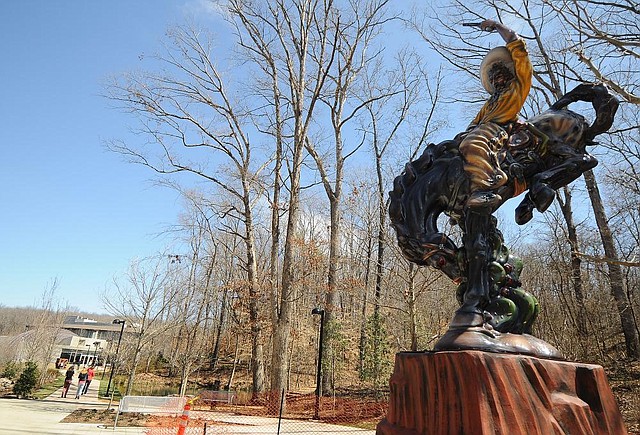Vaquero to rear up along museum trail
Crystal Bridges to install 16-foot sculpture
STAFF PHOTO MARC F. HENNING "Vaquero," a 16-foot-tall polychrome fiberglass sculpture by Luis Jimenez, stands on the Crystal Bridges Art Trail in Bentonville. The sculpture is a permanent part of Crystal Bridges Museum of American Art's collection.
Thursday, March 21, 2013
BENTONVILLE - A large fiberglass sculpture of a Mexican cowboy atop a bucking bronco is being installed this week along the art trail at Crystal Bridges Museum of American Art.
Vaquero by the late sculptor Luis Jimenez recently emerged after two years of tedious work at a conservatory in Houston and will be placed in the Twin Bridges area near the museum’s South Lawn. Crews will usea crane to install it, not just because of its size, but also for safety reasons.
Jimenez died in his studio in New Mexico seven years ago this summer when a 9,000-pound section of a similar work, the 32-foot Blue Mustang, fell on him and severed an artery in his leg. He was 66.
Blue Mustang, a rearing cobalt blue horse with glowing red eyes, is on display at Denver International Airport.
The smaller 16-foot Vaquero was once considered for the space at the entrance of the museum’s restaurant, Eleven, where Claes Oldenburg’s Alphabet/Good Humor prominently stands, “but we realized we couldn’t actually fit it in the building,” said Kevin Murphy, curator of American art.
“It’s bigger than anything else that we have out there,” Murphy said of the outdoor art on the museum’s trails. “It’s a really dynamic work.
The museum’s sculpture was created in 1987-1988, the third in a series of five plus the artist’s proof, which is featured outside the Smithsonian American Art Museum. An artist’s proof is the first of a series approved by the creator before it is duplicated.
Jimenez was Texas-born, but of Mexican descent. His polychrome fiberglass sculptures, celebrating Hispanic life and culture, have been on display at the Art Institute of Chicago, the Museum of Fine Arts in Houston, the Museum of Modern Art and the Whitney Museum of American Art. Murphy declared the sculptor one of the most prominent Southwestern and Latin American artists working in the postwar period.
He said Vaquero represents the diversity of the country and is a commentary of sorts on the American West, past and present. Crystal Bridges acquired the piece in fall of 2011 from the estate of the late Frank Ribelin.It had been on loan to the El Paso Museum of Art since 1998 and was loved by the people of the city where Jimenez was born.
An earlier version of Vaquero has been on display in Moody Park in Houston since 1980. Public reaction to the one there “has been a little mixed, said Jimmy Castillo, civic art collection manager and project manager for the Houston Arts Alliance. The sculpture was commissioned by the city in a predominantly Hispanic neighborhood after violent clashes between residents and police and the city’s government in the late 1970s, he said.
“The placement of the sculpture has always been kind of a touchy point for the immediate community. While some really enjoy it. Some really hate it,” Castillo said.
“However, I think most people in the larger community consider this to be one of the real showpieces of the city’s collection,” he said. It’s been the topic of much discussion since the riots, he added.
“I’m not sure I can speak for the late artist or his estate, but the one time that I did get to see him speak about the piece, what stood out in my mind was the fact that he seemed to be supportive of community sentiment but also wanted to try and express that he felt that sculpture was very important in Moody Park, in that place, because of these tensions.”
The artist lived in New York for a time before making it as an artist and teaching at the University of Arizona and the University of Houston.
Arkansas, Pages 9 on 03/21/2013
